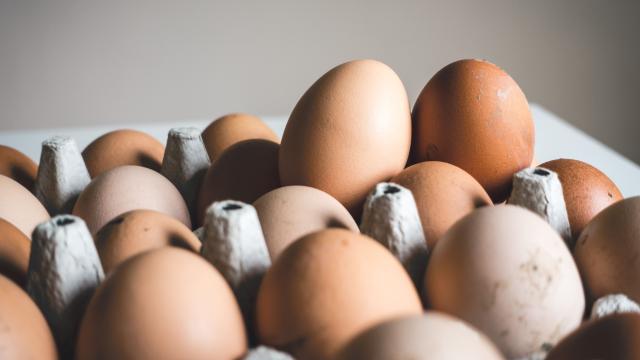A hard-boiled egg is a largely underrated food. Often overlooked for sexier egg varieties like poached or scrambled, the humble boiled egg is regularly left to the side. But if cooked correctly, these babies are a delicious addition to salads, breakfast dishes or even just used as a snack.
Where a lot of us lose our patience with the boiled egg, however, is when it comes to peeling those things. We’re often doing it completely wrong.
Photos by Claire Lower.
Though my Better Homes and Gardens cookbook had served me well in other endeavours, it was just plain incorrect in the matter of hard-boiled eggs. The recipe, which instructed one to place the eggs in a pot of cold water, bring it to a boil, then cover and remove from the heat, was deeply flawed. Though the eggs would be cooked “properly,” their shells seemed to have severe separation anxiety, and large chunks of white would peel off with them.
But then I read The Food Lab’s hard-boiled egg treatise, and the heavens parted and my life has been better. You see, a cold start simply doesn’t work out well. As Kenji explains, the whites of eggs that are gradually heated bond strongly to the membrane, and that membrane will eff your egg right up.
There are two ways I cook my hard-boiled eggs: boiling them on the stove and steaming them in my Instant Pot. Both result in eggs that peel beautifully 98% of the time.
On the stove
To hard boil eggs on the stove, you will need:
- Eggs (As many as you like. Don’t worry about using “older eggs” either. I have not found fresher eggs to be harder to peel.)
- A pot or saucepan
- Water
- An ice bath
Bring the water to a boil and gradually lower your eggs in. Set a timer for seven minutes and find a short activity to pass the time. (I usually check my social media or take pictures of my dog.) Once the timer goes off, immediately transfer the eggs to an ice bath, and let them chill for at least fifteen minutes.
Once chilled, peel the eggs by gently tapping them on a flat surface to form cracks all over, then pry away the shell under running water.
If you like your hard-boiled eggs like I do — firm but still slightly fudgy and not at all dry — seven minutes is the perfect cooking time, but feel free to add a minute or too if you like them a little more done.
Daaaamn yoooouuuu!
You could cook eggs this way your whole life and be pretty satisfied, but you would notice one small annoyance: one of the eggs almost always cracks upon being placed in the boiling water.
A wonky egg that cracked under the pressure.
This isn’t usually a big deal, as I feed the wonky egg to my egg-obsessed spaniel, but it’s not optimum I guess. If you wish to crack down on unwanted egg ruptures, I suggest you try steaming.
In the steamer
“SIP” stands for “Steaming Instant Pot”
Steaming eggs can be done using a steamer basket and pot or an appliance with a steamer function such as the Instant Pot. In either case, you will need:
- Eggs
- Enough water to come up about an inch in whatever vessel you’re using
- A pot for the stove or the liner for your steamer
- A trivet or steamer basket.
- An ice bath
If you’re steaming on the stove, fill a pot with about an inch of water, place a steamer basket or trivet down in there and bring it to a boil. Gently lower your eggs into the basket, cover, and let cook for 11 minutes. Remove from the basket and immediately place the eggs in an ice bath for at least 15 minutes. Peel as described above.
If you are using an electric steamer, you may have to play around with timing a bit, depending on the model. For the Instant Pot however, you just need to add a cup of water to the insert, place the trivet down in there, and set the eggs on the trivet. Close the Instant Pot, set the release valve to “sealing,” and press the “Steam” button. Set the time for seven minutes using the “+” and “-” buttons, and check your Twitter or something. Once the timer has gone off, manually release the pressure by switching the release valve to “venting,” then remove the eggs from the pot and place them in an ice bath for at least fifteen minutes. Peel as described above.
Just beautiful.
I have found that, though the stovetop eggs are easy to peel, the steamed eggs peel even more easily, and have less dents and dimples than their stove-top brethren. Dents and dimples aren’t the end of the world though. I’m a pretty happy camper as long as I get to keep all of my white.
This article has been updated since its original publication.

Leave a Reply
You must be logged in to post a comment.